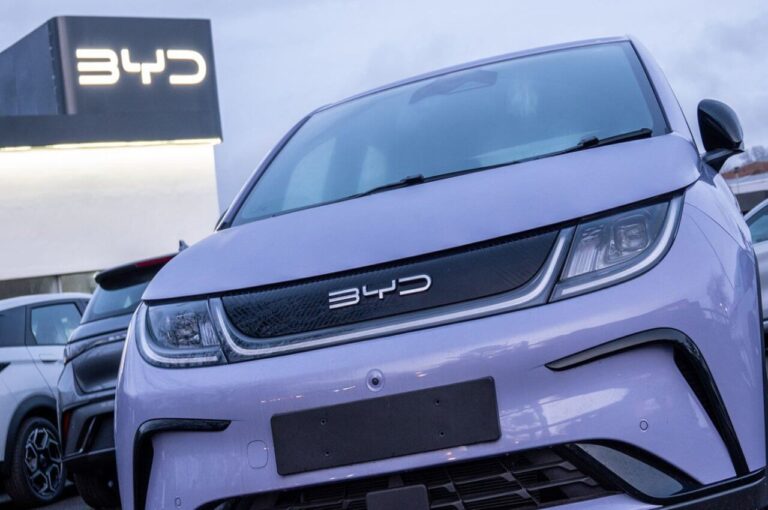The electric vehicle (EV) race has a new frontrunner, and it’s not who you might expect. BYD, the Chinese automaker once considered an underdog, has just pulled off a historic feat, crossing $100 billion in annual sales and overtaking Tesla in global revenue. That’s right—Tesla, the brand that dominated the EV scene for years, has now been outpaced by a company that’s quietly but aggressively reshaping the industry.
So, how did BYD go from being a battery maker to a global EV powerhouse? What’s driving its explosive growth, and what does this mean for the future of the EV market? In this deep dive, we will take you through how BYD’s cutting-edge technology, strategic market moves, and government-backed momentum helped it surpass industry giant Tesla, and what this shake-up means for car buyers, investors, and the future of sustainable transportation. Let’s get into it.
The Rise of BYD: Transforming China’s Electric Vehicle Market
Founded in 1995 by Wang Chuanfu, BYD initially focused on manufacturing rechargeable batteries. The company ventured into the automotive industry in 2005, leveraging its expertise in battery technology to produce electric vehicles.
Over the years, BYD has become a dominant force in China’s EV market, capitalizing on the country’s growing demand for sustainable transportation. In 2024 alone, BYD sold 4.27 million vehicles, solidifying its position as the new leader in the EV industry.
Inside BYD’s Success: Innovative Battery Technology and Market Strategies

BYD is not just about building cars, it’s revolutionizing how we power them. One of its biggest breakthroughs is its cutting-edge battery technology. Imagine this: an EV that can gain 250 miles of range in just five minutes of charging. That’s exactly what BYD has achieved, tackling one of the biggest concerns for EV drivers, long charging times. With this innovation, electric cars become more practical than ever, making range anxiety a thing of the past.
But BYD’s success is not just about fast-charging batteries. The company has also played it smart with its plug-in hybrid strategy. Instead of going all-in on fully electric cars, BYD offers a mix of both hybrids and pure EVs. This approach has given them an edge, especially in regions where charging stations are still catching up. By giving consumers more options, BYD has widened its appeal and secured its place as a dominant force in the global EV market.
Comparing Titans: How BYD Surpassed Tesla in Global Sales

In 2024, BYD reported revenues of $107 billion, surpassing Tesla’s $97.7 billion for the same period. This marks the first time BYD has overtaken Tesla in annual revenue, highlighting its growing influence in the global EV market.
BYD’s rise to the top is the result of smart decisions and strategic advantages that have given it an edge over Tesla. Here’s why BYD is pulling ahead:
- A wider product range – Unlike Tesla, which focuses solely on fully electric vehicles, BYD offers both EVs and plug-in hybrids. This gives buyers more choices, especially in regions where charging infrastructure is still catching up. Plug-in hybrids provide a smoother transition for customers who aren’t ready to go fully electric, expanding BYD’s potential market.
- Aggressive global expansion – BYD is not just dominating China, it’s making bold moves internationally. The company has expanded into Europe, Southeast Asia, Latin America, and even Tesla’s home turf, the U.S. By setting up new factories and forming strategic partnerships, BYD is rapidly growing its global presence while Tesla remains heavily dependent on its existing markets.
- Competitive pricing – One of BYD’s biggest advantages is affordability. Thanks to lower production costs and government subsidies, BYD offers high-quality EVs at significantly lower prices than Tesla. This makes BYD cars more accessible to a wider audience, driving up sales numbers while Tesla struggles with high production costs and fluctuating price cuts.
- Advanced battery technology – As a former battery manufacturer, BYD has a clear technological advantage. Its Blade Battery is safer, longer-lasting, and more efficient than many competitors’ offerings, giving BYD a strong reputation for reliability. In contrast, Tesla still relies on third-party suppliers for some of its battery needs, limiting its control over production.
- Tesla’s challenges & controversies – While BYD is gaining momentum, Tesla has hit some roadblocks. Production slowdowns, supply chain issues, and increasing competition have impacted its sales. Additionally, Elon Musk’s controversies—ranging from erratic tweets to political statements—have influenced public perception and investor confidence, potentially affecting Tesla’s long-term growth.
Government Support & Economic Trends: Driving BYD’s Record-Breaking Performance
Government policies have played a pivotal role in BYD’s success. China’s state-led industrial policies and subsidies for new energy vehicles have provided a conducive environment for EV manufacturers. These initiatives have accelerated the adoption of electric vehicles, positioning companies like BYD at the forefront of the market.
Economic trends also favor BYD’s growth. The increasing global emphasis on sustainability and reducing carbon emissions has led to a surge in demand for electric vehicles. BYD’s ability to meet this demand with innovative and affordable options has further solidified its market position.
Future Outlook: What BYD’s $100 Billion Milestone Means for the EV Industry
BYD’s achievement of surpassing $100 billion in sales is a testament to the company’s strategic vision and execution. Looking ahead, BYD aims to expand its global footprint by establishing manufacturing facilities in countries like Thailand and Uzbekistan, further enhancing its production capabilities and market reach.
However, challenges remain. The global EV market is becoming increasingly competitive, with traditional automakers and new entrants vying for market share. Supply chain constraints and geopolitical factors could also impact production and sales. Nevertheless, BYD’s track record of innovation and adaptability positions it well to navigate these challenges and continue its trajectory of growth.
What’s More?
BYD’s rise to the top is more than just a milestone, it’s a sign of how fast the EV industry is evolving. With cutting-edge technology, smart market strategies, and unbeatable pricing, BYD has proven that Tesla isn’t the only name in the game anymore. As competition heats up, one thing is clear: the future of electric vehicles is more exciting than ever.
What do you think? Is BYD the new king of EVs, or does Tesla have a comeback in the works? Drop your thoughts in the comments! And if you enjoyed this breakdown, share it with fellow EV enthusiasts, because the revolution is just getting started.Want to stay ahead of the latest business trends and industry insights? Subscribe to our weekly newsletter and stay in the know—because smart business decisions start with BizHedge.





